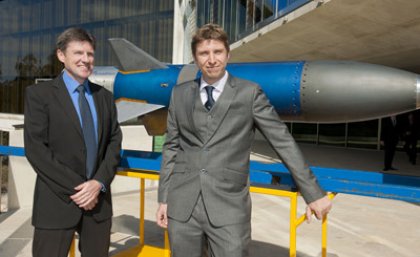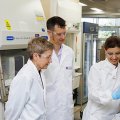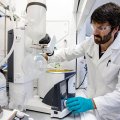
Australia’s hypersonic scramjet takes its first flight this week, but at a pace far slower than the eight times the speed of sound it is set to achieve in September.
Though it is capable of speeds of up to 8600km/h, the SCRAMSPACE hypersonic scramjet research project, led by The University of Queensland, is unlikely to go much faster than 860km/h as it is freighted to the launch site.
The scramjet is scheduled to leave Australia in the next week and arrive in Norway about a week later.
Travelling at its own top speed SCRAMSPACE would cover the 15,410km from Brisbane to Oslo in less than two hours.
SCRAMSPACE Director and Chair for Hypersonics at UQ Professor Russell Boyce said the scramjet had the potential to solve international aerospace challenges and the project demonstrated that Australia is a world leader for scramjet research.
“This three-year, $14 million project has the potential to deliver solutions for sending satellites into space more efficiently and at a much lower cost,” Professor Boyce said.
“Our team includes our international partners. The data they collect will give insights into hypersonic physics, hypersonic combustion, performance of materials and components, and how these vehicles will fly in future.
“As part of the Australian Space Research Program, this project supports Australia’s access to space, as well as building the talent pool of engineers, scientists and specialists we need to do it.”
The scramjet will be launched at Andøya Rocket Range, 300km inside the Arctic Circle in September, subject to weather and testing.
Professor Boyce said the shipment to the launch site in Norway was an important step towards the launch.
Dr Melrose Brown, one of the SCRAMSPACE flight team, said the international research team of 13 partners and four sponsors (below) were primed for take-off, and the various data that will be collected during the short three second flight window, before the scramjet self-destructs over the sea.
“The team is extremely excited about the potential impact of the data that comes out of this test flight,” said Dr Brown.
“For example, we will be testing high-temperature materials that could change the face of manufacturing industries.”
Following launch, the spacecraft will reach an altitude of 340 kilometres using a two-stage rocket. After leaving the atmosphere, the scramjet vehicle will separate from the rocket and orient itself for re-entry using small thrusters in preparation for what Professor Boyce describes as a “hypersonic swan dive”.
During the return flight, gravity will accelerate the vehicle to Mach 8 – about 8600km/h. This is when the team will collect the most valuable data, before the scramjet self-destructs over the sea as planned.
As well as leading one of the world’s fastest research projects, The University of Queensland has is responsible for one of the world’s slowest and longest running– the Pitch Drop Experiment.
Other examples of UQ research excellence include cervical cancer vaccine Gardasil, a research centre to create cheaper fuel from algae, Australia’s largest rooftop PV solar installation, addressing global change, food security, and developed titanium fabrication technology for aerospace materials.
Media, images and access to launch footage: Janelle Kirkland, UQ Communications, 07 3346 0561 or j.kirkland@uq.edu.au
Footage and photos will be made available to media following the launch.
Website: http://hypersonics.mechmining.uq.edu.au/scramspace1
Facebook page: https://www.facebook.com/ScramspaceOne?fref=ts
Twitter: https://twitter.com/ScramspaceOne
About the SCRAMSPACE project
SCRAMSPACE is the first and largest project funded by the Australian Space Research Program. It builds on Australia's world-class hypersonics heritage, and its core objective is to build capacity and capability, in particular a talent pool, for the Australian space and aerospace industry.
This is achieved partly by means of the Mach 8 flight experiment, for which a team of exceptional young scientists and engineers has been assembled, and partly through extensive ground-based research involving many PhD students at UQ and partner universities.
Partners in the program include UQ, the University of New South Wales, the University of Adelaide, the University of Southern Queensland and the University of Minnesota.
It also includes Australia's Defence Science and Technology Organisation, which has assisted with design, testing, certification, training and access to equipment; industry partners BAE Systems, Teakle Composites and AIMTEK; aerospace agencies and research organisations from Germany (DLR), Japan (JAXA) and Italy (CIRA); and the Australian Youth Aerospace Association.
About The University of Queensland (UQ)
The University of Queensland, Australia, is one of the world’s premier teaching and research institutions. It is consistently ranked in the top 100 in the four leading independent global rankings. With more than 45,000 students and 7500 staff, UQ’s teaching is informed by research, and spans six faculties and eight research institutes.











